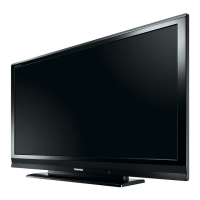
Do you have a question about the Toshiba 32AV623D and is the answer not in the manual?
| Screen Size | 32 inches |
|---|---|
| Resolution | 1366 x 768 |
| Display Type | LCD |
| HD Technology | HD Ready |
| Aspect Ratio | 16:9 |
| Contrast Ratio | 30000:1 (Dynamic) |
| Brightness | 450 cd/m² |
| Response Time | 8 ms |
| HDMI Ports | 3 |
| USB Ports | 1 |
| Component Video Input | 1 |
| Composite Video Input | 1 |
| PC Input | 1 (VGA) |
| Audio Output | 2 x 10W |
Essential safety guidelines for TV setup and operation, covering ventilation, heat, and power supply.
Guidance on TV placement, cleaning, and important notes for proper installation, including exclusion clauses.
Overview of remote control functions, button layout, and battery replacement, including effective range.
Instructions for connecting various external devices like decoders, media recorders, and audio systems.
Detailed steps for connecting devices using HDMI or DVI interfaces for video and audio transmission.
Guide on connecting a PC via RGB/PC or HDMI terminals for display and audio output on the TV.
Explanation of the TV's physical buttons and how to switch between different input sources.
Guided initial setup process for language, country, and channel tuning.
Configuration for antenna or cable input, including DTV tuning settings like frequency and modulation.
Process for automatically scanning and tuning available digital and analogue TV channels.
Step-by-step guide for manually tuning analogue TV channels, including system and fine-tuning options.
How to skip unwanted channels and reorder the channel list for easier navigation.
Manual tuning for digital channels, useful for specific frequency or multiplex entry.
Configuration options for digital TV, including channel management, subtitles, audio, and updates.
Choosing between 'Home' and 'Store' modes to optimize TV settings for different environments.
Enabling automatic updates for new digital channels when the TV is in standby.
Setting the character set for DVB-C or DVB-T channels for proper display of text.
Information regarding the eventual phasing out of analogue TV services and re-tuning advice.
Basic operation of TV controls, including channel selection and on-screen information display.
Adjusting volume, mute, equalizer settings, and advanced audio features for optimal sound.
Options for displaying content in various aspect ratios like WIDE, 4:3, and CINEMA modes.
Comprehensive guide to adjusting picture settings like brightness, contrast, colour, and modes.
How to use the Photo Viewer to display JPEG images from a USB storage device.
Accessing and managing features like Panel Lock and Toshiba Illumination.
Setting up Programme Timers and On/Sleep Timers for automated TV operation.
Using the EPG to view programme details, schedule recordings, and access channel information.
Navigating the TV guide and searching for programmes by genre.
Implementing parental controls, setting a PIN, and restricting content access.
Managing favourite channels, skipping channels, and locking channels for digital TV.
Configuring subtitles, audio languages, and common interface settings for digital broadcasts.
Information on automatic and manual software updates to improve TV functionality.
Checking system details, software version, and resetting the TV to factory defaults.
Adjusting picture position, clock phase, and sampling clock for PC input.
Managing TV inputs, selecting signal types, and configuring PC audio connections.
Choosing between Fastext (Auto) and saved favourite pages (LIST) for text services.
Viewing text services, accessing pages, and managing sub-pages dynamically.
Methods for navigating text pages using coloured buttons or direct entry.
Explanation of remote control buttons specific to text service navigation and display.
Common issues and their solutions for picture, sound, remote control, and connectivity problems.
Understanding the meaning of front panel LED lights and troubleshooting based on their status.
Legal information regarding AVC patent portfolio license and MPEG LA.
Guidelines for cleaning the TV screen and cabinet, and proper disposal methods for products and batteries.
Technical details on PC signal formats for Mini D-sub and HDMI connections.
Technical specifications, dimensions, power consumption, and included accessories.